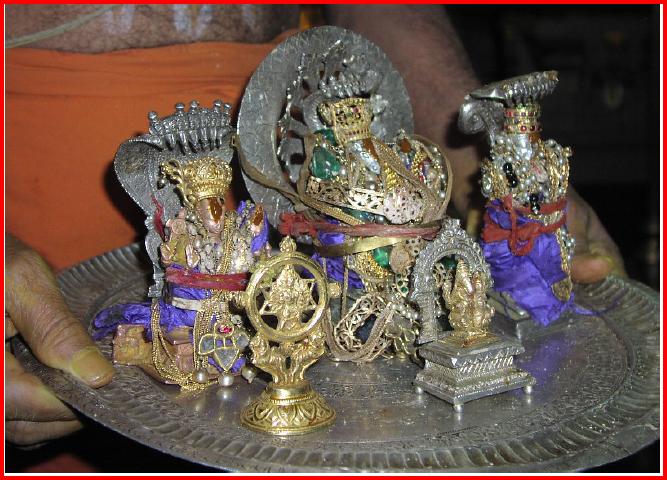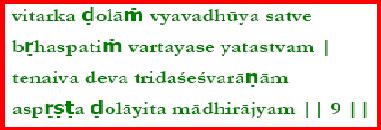
Oh Lord HayagrIvA! Thou doest do away with the faulty ways of thought of Bruhaspathi(which make him waver and falter with regard to what is the highest of truth) and establish himin the Satthvic (righteous) path. It is because of that the chiefs among DevAs enjoy their highposts and positions without oscillations (i.e) permanently.
The play that Swamy Desikan has on the word “DhOlA” is very amusing and enjoyable(rasOkthi). Bruhaspathi’s mind was moving like a swing from here to there without steadinessand the Lord intervened and put an end to those perilous movements and stabilized (anchored)Bruhaspathi’s mind in the satthva maargam (Deva! thvam Vitarka DhOlAm vyavadhUyaBruhaspathim satthvE yatha: VarthayasE).
What is the consequence of stabilizing Bruhaspathi’s mind through the Lord’s sadupadesam?The Lord’s merciful intervention prevented the kingdoms of DevAs from swinging wildly andfalling under the sway of DhAnavAs (asurAs). Swamy Desikan suggests playfully that Lord HayagrIvan put an end to the oscillations (doubts) of the mind of Bruhaspathi, which in turnput an end to the oscillations of his sishyA’s kingdom (tEna yEva Thridasa IsvarANAmAadhirAjyam asprushta DhOlAyitham).
DhOlAyitham means swinging back and forth. Asprushtam means incapable of. Thus thestraightening out of the vagaries of mind of the AchAryan of the DevAs saved the kingdom ofDevAs from undergoing any swings in prosperity and stability. Such is the UpakAram of Lord HayagrIvan! In the 8th and the 9th slOkams, Swamy Desikanreferred to the paramOpakAram of Sri HayagrIvan to His son (Brahman) and grandson (DevaPurOhithar, Bruhaspathi). The Brahmanaspathi’s help to Bruhaspathi was covered in the 9thslOkam.
In the 10th slOkam deals with the special occasions, where Lord HayagrIvan accepts the Havisin a Yaj~nam directly and then distributes them to the DevAs. Normally, when the YajamAnancalls the name of the DevAs to receive their share of Havis, they stretch their hands and receivethem directly. In most of the times, Agni Devan serves as an intermediary in the delivery of theoffered Havis in Yaj~nams and Yaagams.
An example of a special case, where the Lord Himself received the Havis directly is theAsvamEdha Yaagam of Brahma Devan performed on top of Hasthi Giri. There, LordHayagrIvan in the form Of VaradarAjan appeared in the middle of the towering agni jwAlais ofthe Yaaga KuNtam in PuNyakOti VimAnam and received the Havis directly and made BrahmaDevan very happy and fulfilled. The assembled DevAs stretched their hands as their nameswere called, but the havis “eluded” their outstretched hands. The Lord accepted the sacredoffering and the DevAs were told by Brahma that he was performing a special Yagnam with aspecific motive as explained in the dhivya sookthis of Swamy Desikan such as Sri VaradarAjaPanchAsath (SlOkam 8), Hasthigiri MahAthmyam and in BrahmANda PurANam (SatyaVratha KshEthra Vaibhavam).
As revealed by BhishmA in Sri VishNu Sahasra Naamam, Our Lord is to be worshipped as:BhUrbhuva: svastharu: thAra: SavithA PrapithAmaha:
Yaj~nO Yaj~pathir YajvA Yaj~ngO Yaj~na Vaahana: (104)
Yaj~na Bhruth Yaj~nee Yaj~bhug Yaj~na saadhana:
Yaj~nthakruth Yaj~na Guhyam annam annadhA yEva cha (105)
Eighteen Sri VishNu Sahasra NaamAs are associated with Yaj~nam, Havis, the YajamAnA ofthe Yaj~nam and His specific roles in Yaj~nam. He is the Taarakan, who helps us as a boat tocross the ocean of SamsAram. It is interesting that the name of PithAmaha (Grand fatherBrahma Devan) is included here, when the Lord’s name is recited as PrapithAmahan (TheGreat Grand Father, Sri HayagrIva Varadhan). He is the Yaj~na pathi (the Presider over theYaj~nam). He is the Yajvaa (performer of the sacrifice for those, who are unable to do the Yaj~nam). He does this at both dawn and dusk on behalf of those, who are unable to performthese Yaj~nams. This is His Vratham. He is the Yaj~na Bhruth (the concluder of theYaj~nam) through the ritual of PoorNAhUthi. He the Seshi of Sarva Yaj~nams including thatof Brahma Devan on top of Hasthi Giri. Most importantly, He is the enjoyer of the havis of allYaj~nams (Yaj~na Bhuk). That is the secret of all the sacrifices (Yaj~na Guhyam). He is theannam (the object of enjoyment) and annAdha (the enjoyer of those who enjoy Him throughthe performance of the Yaj~nAs.
As declared by Him in His GithOpanishad, He is the enjoyer of the Yaj~nam as well as theLord of that Yaj~nam (ahamhi Sarva yaj~nAnAm BhOkthA cha PrabhurEva Cha). He is theantharyAmi of all the DevAs and receives the Havis (oblations).
The tenth slOkam of Sri HayagrIva sthOthram is about these profound tatthvams and adiyEn will cover them in the next posting.
In the 7th, 8th and the ninth slOkams, Swamy Desikan saluted the great anugraham forDakshinAmUrthy Sivan, BrahmA and Bruhaspathi. In the 10th slOkam, the sacred manthricform (the form constitued entirely by Veda Manthrams) receiving the oblations fromyajamAnAs of Yaj~nams is saluted.
A DIGRESSION:
I will digress a little here in response to a request for elaboration on the ThirumazhisaiAzhwAr’s paasurams that I quoted earlier in the context of the seventh slOkam of SriHayagrIva sthOthram (Aala nizhark Keezh aRa neRiyai naalvarkku mEluraithAn meyttavatthOn).There was a question from a BhakthA as to what DakshiNA Moorthy Sivan taught to the fourrishis assembled under His feet for sadupadEsam. Thirumazhisai AzhwAr himself describesthe topic for instruction in the second half of the above paasuram of NaanmukanThiruvandAthi this way:
“JnAlamaLanthAnai AazhikkidanthAnai, aal mEl vaLarnthAnait thaan vaNangumARu
“ –Naanmukan ThiruvandhAthi: Paasuram 17
Thirumazhisai refers to the unalloyed devotion of DakshiNAmUrthy Sivan to SrimanNaarAyaNA here. AzhwAr says here that it is not only himself, who comprehends the ParaTatthvam of Sriman NaarAyaNan, but it is is also DakshiNA Moorthy Sivan sitting under thegolden pupil tree (svarNa Vata Vruksham) knows about it and instructs the four great sagesthrough mounam and nayana dheekshai (initiation through mere katAksham/glances).The subject matter of the initiation is the Lord who measured the worlds with three steps (OngiUlahaLantha Uttaman), who performs Yoga NidhrA on the bed of Adhi Seshan in the middleof milky ocean (KsheerAbdhi Naathan) and the same One who floats on the roaring waters ofPraLaya Jalam (waters at the time of deluge) on a small pupil leaf as a tiny baby (Vata pathraSaayee) while keeping all the worlds safely tucked away in His little stomach nonchalantly forthe next period of Srushti (creation). Thirumazhisai points out that DakshiNA Moorthy-Sivan was teaching these eminent sages theway in which He Himself worships His Lord and grandfather, Sriman NaarAyaNan with totaldevotion.
Source
To be continued…









